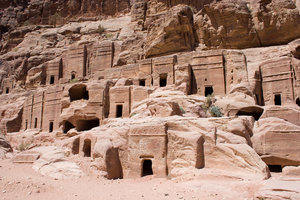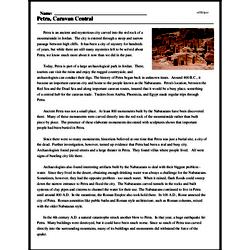Petra, Caravan Central
Petra is an ancient and mysterious city carved into the red rock of a mountainside in Jordan. The city is entered through a steep and narrow passage between high cliffs. It has been a city of mystery for hundreds of years, but while there are still many mysteries left to be solved about Petra, we know much more about it now than we did in the past.
Today, Petra is part of a large archaeological park in Jordan. There, tourists can visit the ruins and enjoy the rugged countryside, and archaeologists can conduct their digs. The history of Petra began back in unknown times. Around 400 B.C., it became an important caravan city and home to the people known as the Nabataeans. Petra's location, between the Red Sea and the Dead Sea and along important caravan routes, insured that it would be a busy place, something of a central hub for the caravan trade. Traders from Arabia, Phoenicia, and Egypt made regular trips through Petra.
Ancient Petra was not a small place. At least 800 monuments built by the Nabataeans have been discovered there. Many of these monuments were carved directly into the red rock of the mountainside rather than built piece by piece. The presence of these elaborate monuments decorated with sculptures shows that important people had been buried in Petra.




